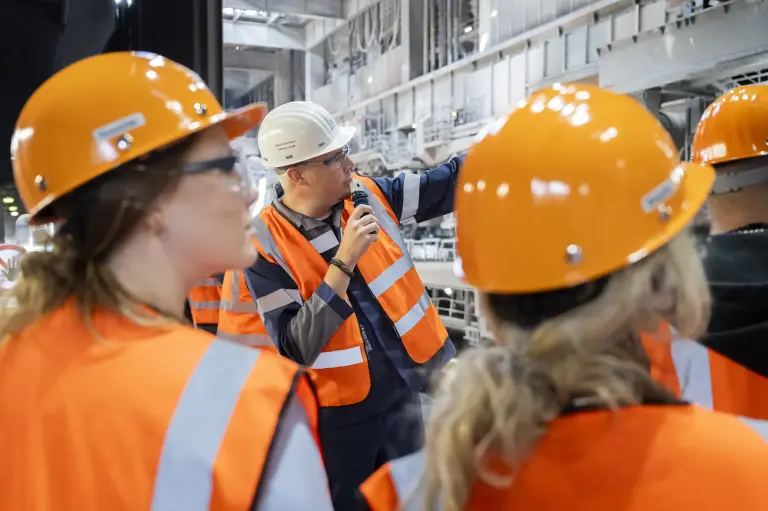My name is Matthias Eikelmann and I am 42 years old. Although I didn't learn a technical profession, I come from a steel family. My father is a graduate engineer and worked for many decades in the steel industry and also at thyssenkrupp Steel, which he in turn inherited from my grandfather. So I grew up with steel and have always had a certain familiarity with this material. I have always had an interest in steel and a desire to work in this industry.
The idea of developing my career in this direction came later. I came across a job advertisement from thyssenkrupp Steel looking for freelance guides. Initially, I had reservations because I thought it might be difficult to answer technical questions competently. But my colleagues at the visitor center quickly allayed my fears. The trainings were really excellent and I was given everything I needed to carry out the tours successfully. I became part of the team and have now been enthusiastically guiding visitors through our plant for a year.
A typical working day for me starts before the plant tour begins. First, I take my time to prepare by looking at the tour program and checking which units will be visited during the tour. Then I look at the list of participants to find out how many guests are registered and whether there are any special requirements.
Preparation also includes setting up the guide radios, which we use to provide participants with information during the tour. When the guests arrive, I give them a warm welcome and register them. I then take the group to our 300-degree movie theater, where we show our production film. The film gives a schematic overview of what a steel mill is, what we produce and how we do it.
Another important part of the preparation is showing a safety film. As we are a manufacturing company and not a museum, there are high safety requirements for us guides and for our guests. After the film, the guests receive their protective equipment, consisting of a helmet, goggles and safety vest, and we get on the bus to start the plant tour.
The most important requirement is to enjoy working with people. If you enjoy working with people and are communicative, you have the best basis for this job. Everything else, especially the technical background, can be learned.
Physical fitness is also important, as you have to walk long distances. There are often stairs up and down, and the terrain is vast. Language skills, especially English or another foreign language, are an advantage, but not a must. The ability to work in a team is essential, because you have to be able to rely on your colleagues at all times and vice versa.
The job as a guide is very easy to combine with your studies. Thanks to the flexible planning, you can coordinate your working hours with your lecture and exam schedule. You enter your availability in an online tool and can therefore work stress-free.
The job also gives you the opportunity to gain valuable experience in dealing with people and improve your communication skills. You learn a lot about the industry and the processes involved in steel production, which can also be an advantage in your future career. And, of course, you already have one foot in the door at one of the largest steel producers in Europe.
Getting to know each other begins with an interview and a taster tour, during which you get to know the processes in the visitor center. If both parties are accepted, workshops follow in which the necessary knowledge about the technical procedures and processes is developed together. This is followed by practical training, during which you carry out the tours with an experienced guide and receive feedback.
This process is individual and everyone can learn at their own pace. No one is put under pressure to master everything in a short space of time. The aim is to thoroughly understand the content and procedures and to communicate them safely. You receive continuous support and feedback during your induction, which is very helpful.
One particularly memorable moment was when I visited the oxygen steel plant with a group that initially seemed less interested. When we witnessed live how converter number 3 was filled with scrap and liquid pig iron, the participants were completely fascinated. The sparks literally flew and they were thrilled. It was impressive to see how this moment captivated the group and sparked their interest. That was a very fulfilling experience for me.
Another nice moment was when two participants thanked me warmly after the tour and shook my hand - despite the fact that my hand was dusty. They really thanked me from the bottom of their hearts for the great tour and said that they had never expected it to be so interesting. This recognition and appreciation is very motivating and makes the work particularly fulfilling.
The corporate culture at thyssenkrupp Steel is characterized by collaboration, support and a strong sense of community. Everyone supports each other and I have the feeling that I am part of a larger whole that is working together towards a common goal. There is an open and friendly atmosphere where new ideas and suggestions are welcome. I feel valued and in good hands.
I see myself as a transporter of the idea and vision of thyssenkrupp Steel. My job is to convey to visitors how we currently produce steel and what transformations we are planning for the future, particularly with regard to direct reduction and hydrogen. It is one of the biggest transformation processes in the company's history and I am looking forward to bringing people closer to this important development and leaving them with the good feeling that we are on the right track - for the region, the environment and the future. That makes me representative of the #nextgenerationsteel.
